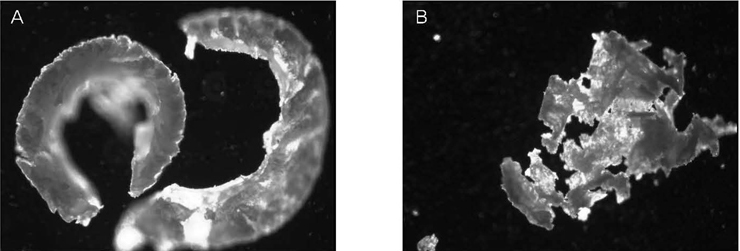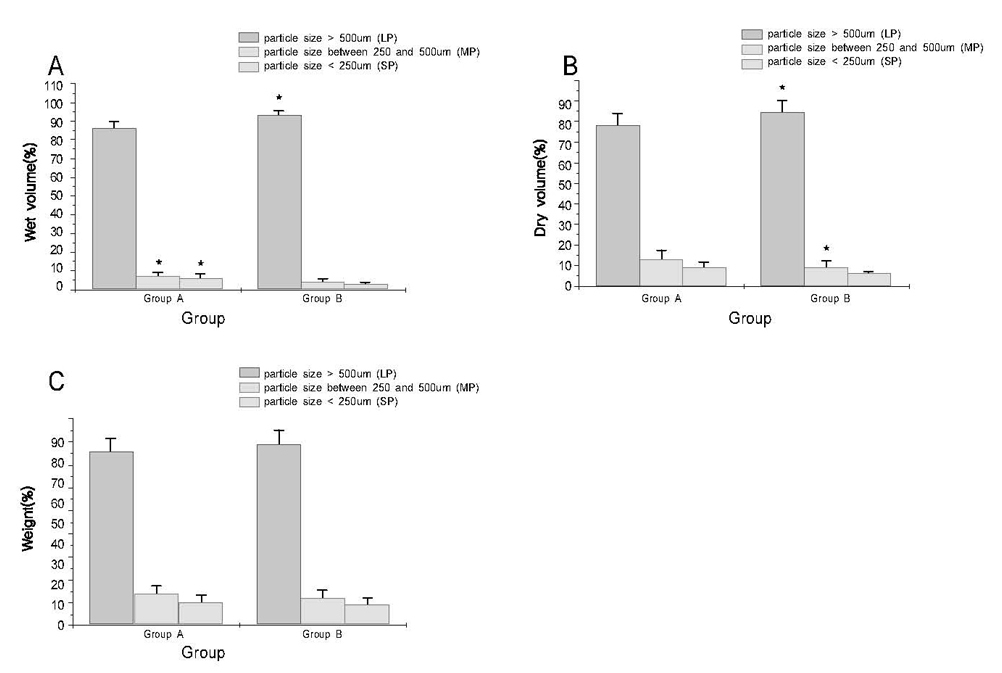J Korean Acad Periodontol.
2009 Aug;39(Suppl):253-259.
The effect of implant drilling speed on the composition of particle collected during site preparation
- Affiliations
-
- 1Department of Periodontics, The Institute of Oral Health Science, Samsung Medical Center, Sungkyunkwan University School of Medicine, Korea. pkoyang@skku.edu
- 2Kim & Jeon dental clinic, Korea.
- 3Department of Oral & Maxillofacial Surgery, The Institute of Oral Health Science, Samsung Medical Center, Sungkyunkwan University School of Medicine, Korea.
Abstract
-
PURPOSE: This study was aimed to evaluate the effect of implant drilling speed on the composition of particle size of collected bone debris.
METHODS
Branemark System (R)drills were used to collect bone debris from 10 drilling holes (1 unit) at 1,500 rpm (Group A) and 800 rpm (Group B) in bovine mandible. After separating particles by size into > 500 microm, between 250 microm and 500 microm, and < 250 microm fractions, particle wet volume, dry volume, and weight were measured and the proportion of 3 fractions of bone debris to total wet volume, dry volume and weight was calculated as wet volume % , dry volume % and weight %.
RESULTS
No significant differences were found between Group A and B in wet volume, dry volume, and weight. However, of > 500 microm fractions, Group B had significantly higher wet volume % (P = 0.0059) and dry volume % (P = 0.0272) than in Group A.
CONCLUSIONS
The drilling speed influenced the composition of particle size in collected drilling bone debris. The drilling in 800 rpm produced the more percentage of large particles than in 1,500 rpm. However, the drilling speed didn't effect on total volume of and weight of bone debris.
Figure
Reference
-
1. Lee Y, Han S, Um H, Kim D. Histologic observation of regenerated bone in human intraosseous Lesion following guided tissue regeneration with calcium carbonate implant and autogenous bone graft. J Korean Acad Periodontol. 1998. 28:263–273.
Article2. Becker W, Schenk R, Higuchi K, Lekholm U, Becker BE. Variations in bone regeneration adjacent to implants augmented with barrier membranes alone or with demineralized freeze-dried bone or autologous grafts: a study in dogs. Int J Oral Maxillofac Implants. 1995. 10:143–154.3. Block MS, Kent JN, Kallukaran FU, Thunthy K, Weinberg R. Bone maintenance 5 to 10 years after sinus grafting. J Oral Maxillofac Surg. 1998. 56:706–714.
Article4. Marx RE. Clinical application of bone biology to mandibular and maxillary reconstruction. Clin Plast Surg. 1994. 21:377–392.
Article5. Seol Y, Lee J, Kye S, et al. The effect of PDGF-BB loaded TCP/chitosan microgranules on new bone formation. J Korean Acad Periodontol. 2002. 32:489–500.
Article6. The effect of PDFG-BB loaded biodeqradable membrane on early healinq stage in quided tissue reqeneration. J Korean Acad Periodontol. 1999. 29:507–519.7. Cheong H, Kim K, Park Y, et al. Osteogenic effects of polyethyleneimine-condensed BMP-2 genes in vitro and in vivo. J Korean Acad Periodontol. 2007. 37:859–869.
Article8. Nkenke E, Radespiel-Troger M, Wiltfang J, et al. Morbidity of harvesting of retromolar bone grafts: a prospective study. Clin Oral Implants Res. 2002. 13:514–521.
Article9. Schlegel KA, Fichtner G, Schultze-Mosgau S, Wiltfang J. Histologic findings in sinus augmentation with autogenous bone chips versus a bovine bone substitute. Int J Oral Maxillofac Implants. 2003. 18:53–58.10. Karacaoglan N, Uysal OA. Use of iliac bone graft for saddle nose deformity. Auris Nasus Larynx. 1998. 25:49–57.
Article11. Lauer G, Schilli W. Collected implant cavity borings used as peri-implant osseous augmentation material. Int J Oral Maxillofac Implants. 1994. 9:437–443.12. Widmark G, Ivanoff CJ. Augmentation of exposed implant threads with autogenous bone chips: prospective clinical study. Clin Implant Dent Relat Res. 2000. 2:178–183.
Article13. Young MP, Worthington HV, Lloyd RE, et al. Bone collected during dental implant surgery: a clinical and histological study. Clin Oral Implants Res. 2002. 13:298–303.
Article14. Zaner DJ, Yukna RA. Particle size of periodontal bone grafting materials. J Periodontol. 1984. 55:406–409.
Article15. Kainulainen VT, Kainulainen TJ, Oikarinen KS, Carmichael RP, Sandor GK. Performance of six bone collectors designed for dental implant surgery. Clin Oral Implants Res. 2006. 17:282–287.
Article16. Iyer S, Weiss C, Mehta A. Effects of drill speed on heat production and the rate and quality of bone formation in dental implant osteotomies. Part II: Relationship between drill speed and healing. Int J Prosthodont. 1997. 10:536–540.17. Iyer S, Weiss C, Mehta A. Effects of drill speed on heat production and the rate and quality of bone formation in dental implant osteotomies. Part I: Relationship between drill speed and heat production. Int J Prosthodont. 1997. 10:411–414.18. Sharawy M, Misch CE, Weller N, Tehemar S. Heat generation during implant drilling: the significance of motor speed. J Oral Maxillofac Surg. 2002. 60:1160–1169.
Article19. Hoegel F, Mueller CA, Peter R, Pfister U, Suedkamp NP. Bone debris: dead matter or vital osteoblasts. J Trauma. 2004. 56:363–367.
Article20. Eriksson RA, Adell R. Temperatures during drilling for the placement of implants using the osseointegration technique. J Oral Maxillofac Surg. 1986. 44:4–7.
Article21. Marx RE, Miller RI, Ehler WJ, Hubbard G, Malinin TI. A comparison of particulate allogeneic and particulate autogenous bone grafts into maxillary alveolar clefts in dogs. J Oral Maxillofac Surg. 1984. 42:3–9.
Article22. Reingewirtz Y, Szmukler-Moncler S, Senger B. Influence of different parameters on bone heating and drilling time in implantology. Clin Oral Implants Res. 1997. 8:189–197.
Article23. Anitua E, Carda C, Andia I. A novel drilling procedure and subsequent bone autograft preparation: a technical note. Int J Oral Maxillofac Implants. 2007. 22:138–145.24. Savant TD, Smith KS, Sullivan SM, Owen WL. Bone volume collected from dental implant sites during osteotomy. J Oral Maxillofac Surg. 2001. 59:905–907.
Article25. Lee SH, Yoon HJ, Park MK, Kim YS. Guided bone regeneration with the combined use of resorbable membranes and autogenous drilling dust or xenografts for the treatment of dehiscence-type defects around implants: an experimental study in dogs. Int J Oral Maxillofac Implants. 2008. 23:1089–1094.26. Mellonig JT. Decalcified freeze-dried bone allograft as an implant material in human periodontal defects. Int J Periodontics Restorative Dent. 1984. 4:40–55.27. Shapoff CA, Bowers GM, Levy B, Mellonig JT, Yukna RA. The effect of particle size on the osteogenic activity of composite grafts of allogeneic freeze-dried bone and autogenous marrow. J Periodontol. 1980. 51:625–630.
Article28. Sampath TK, Reddi AH. Homology of bone-inductive proteins from human, monkey, bovine, and rat extracellular matrix. Proc Natl Acad Sci U S A. 1983. 80:6591–6595.
Article
- Full Text Links
- Actions
-
Cited
- CITED
-
- Close
- Share
- Similar articles
-
- The effect of low-speed drilling without irrigation on heat generation: an experimental study
- Effects of a simplified drilling protocol at 50 rpm on heat generation under water-free conditions: an in vitro study
- The effect of osteotome technique on primary implant stability according to implant fixture diameter
- Thermal changes during implant site preparation with a digital surgical guide and slot design drill: an ex vivo study using a bovine rib model
- The effect of implant shape and bone preparation on primary stability




